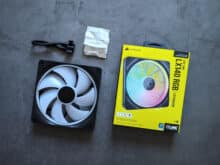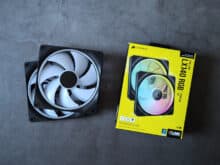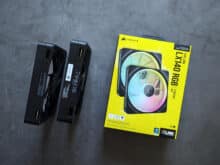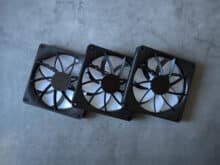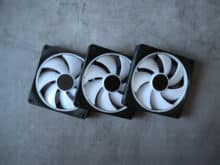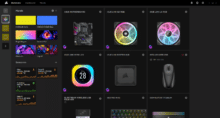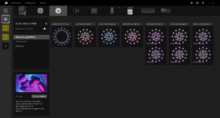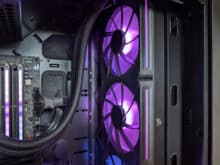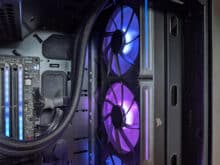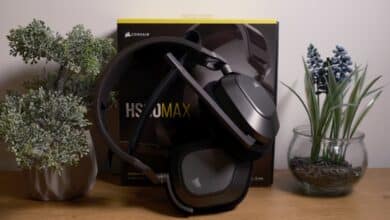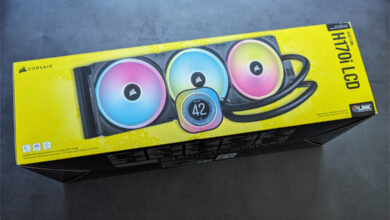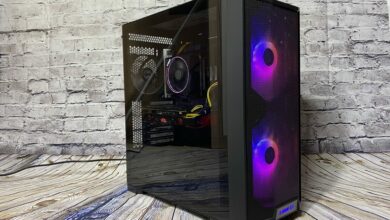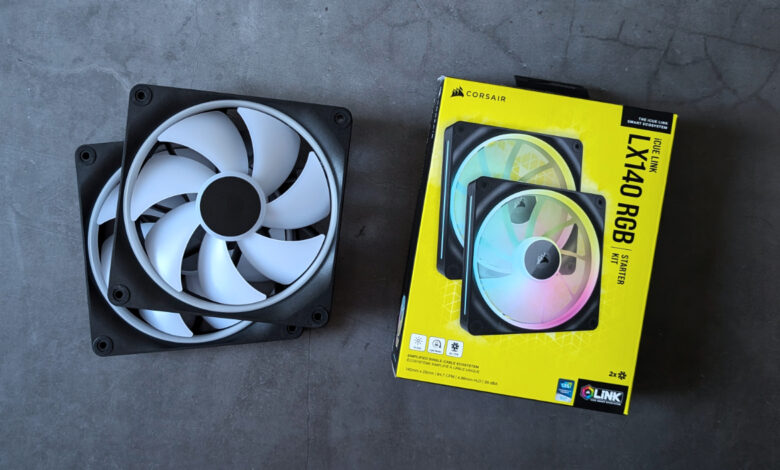
Corsair is expanding the iCUE LINK ecosystem (our review), which already included the QX and RX fans, with the new LX fans. The LX fans are available in sizes 120 (LX120) and 140 mm (LX140) in the colors black and white and are visually similar to the QX fans, but offer slightly less RGB lighting with two light loops and a total of 18 RGB LEDs. Corsair offers the LX fans both individually and as starter kits, which contain three (LX120) or two (LX140) fans as well as a system hub. Three black Corsair iCUE LINK LX140 RGB fans were available for our test.
Technical data of the Corsair iCUE LINK LX140 RGB
| Model | Corsair iCUE LINK LX140 RGB (single fan) |
| Fan speed | 0, 350 – 2,000 rpm ± 10 % |
| Air flow rate | 10.74 – 84.7 CFM |
| Air pressure | 0.11 – 4.86 mmH₂O |
| Noise level | 10 – 36 dB(A) |
| Fan bearing | Magnetic levitation bearing |
| Dimensions | 140 x 140 x 25 mm |
| Special features | Corsair iCUE LINK ecosystem (system hub required), 18 RGB LEDs |
| Scope of delivery | Corsair iCUE LINK LX140 RGB fan, iCUE LINK cable (135 mm), iCUE LINK connectors, QuikTurn screws |
| Warranty period | 5 years warranty |
| price |
€ 49.99 * |
This means that three different fan models are currently available for the iCUE LINK ecosystem. The new LX fans are between the QX and RX fans in terms of airflow and RGB lighting. The AirGuide technology familiar from the RX fans (our test) should contribute to high performance.
| Model | QX140 RGB (Link to the manufacturer) |
LX140 RGB (Link to the manufacturer) |
RX140 RGB (Link to the manufacturer) |
| Air flow rate | max. 82.5 CFM | max. 84.7 CFM | max. 95.7 CFM |
| Air pressure | max. 3.5 mmH₂O | max. 4.86 mmH₂O | max. 3.79 mmH₂O |
| RGB LEDs | 34 | 18 | 8 |
| AirGuide technology |
no | yes | yes |


Scope of delivery
- contains a fan, a cable and a connector set
- a starter kit contains two fans and accessories as well as a system hub
The Corsair iCUE LINK LX140 RGB comes in Corsair’s typical black and yellow box. The fan is shown with RGB lighting on the front. Corsair also makes several references to its membership of the iCUE LINK ecosystem. On the back of the box, Corsair mentions a few highlights and lists the fan’s technical data. The scope of delivery is listed on one of the side panels.
In addition to the fan, the iCUE LINK LX140 RGB (link to manufacturer) comes with a 135 mm long, double-angled iCUE LINK cable, a connector set and the QuikTurn screws familiar from the RX fans, which can be screwed in with just one turn.
The iCUE LINK LX140 RGB starter kit (link to manufacturer) includes two fans, a 600 mm long iCUE LINK cable angled at one end, a 135 mm long iCUE LINK cable angled at both ends, a connector set and QuikTurn screws. The starter kit also contains an iCUE LINK system hub and the associated cables.
Design and workmanship
- Black fan frame and transparent light gray fan blades
- 18 RGB LEDs in two light loops (12 outside, 6 inside)
The Corsair iCUE LINK LX140 RGB have black fan frames and transparent light gray fan blades. The front and sides of the fans look very similar to the QX fans, although the LX fans only have one instead of two light loops with twelve RGB LEDs on the sides. On the other two sides are the iCUE LINK connections, which can be used to connect the fans to the system hub or another fan. The rear with the black stator blades looks very similar to the RX fans. There are rubber rings around the mounting holes to decouple the fans from the housing.
As with the RX fans, black stickers with the Corsair logo are attached to the center of the rotor. As the fan frame is slightly wider than the RX fans, only one cable harness runs along the stator blades to the outside and another through the fan frame. There are also six RGB LEDs in the center of the rotor.
Material quality and workmanship
- Very good material and processing quality
The material and workmanship quality of the Corsair iCUE LINK LX140 RGB is impressive, just like the QX and RX fans in the test. The fan frame is made of sturdy plastic and has a very clean finish, which also applies to the fan blades and the Stato blades. Another practical feature is that the fan frames are magnetic and several fans attract each other when aligned correctly or repel each other when aligned incorrectly.
The iCUE LINK cables are significantly thicker than other fan cables and are therefore also very stable. Thanks to the various cables and connectors available, the fans can be connected to each other as well as to other iCUE LINK components according to your own requirements.
Software and RGB lighting
- Control via Corsair’s iCUE software
The Corsair iCUE LINK LX140 RGB is controlled via Corsair’s iCUE software. The connected fans are automatically recognized and can be distinguished from each other with the help of the System Hub Assistant.
The lighting of the iCUE LINK LX140 RGB can be customized via the sub-item Lighting effects, the RGB LEDs can be controlled individually. There are various effects to choose from, the color, speed and direction of which can be adjusted. The time warp lighting effect known from the QX fans (link to manufacturer) is also supported. The appearance of the fans is very appealing, especially on the front and sides, thanks in part to the two light loops.
The speed of the iCUE LINK -LX140 RGB can be adjusted via the Cooling sub-item. Fixed values as well as a temperature or load curve are available for selection.
Performance and volume of the Corsair iCUE LINK LX140 RGB
- wide control range from 350 to 2,000 rpm
- good performance in the medium to high speed range
Corsair advertises the LX fans as case and radiator fans. The AirGuide technology with stator blades, familiar from the RX fans, is intended to bundle the airflow and contribute to a high static pressure.
We compare the performance and volume of the Corsair iCUE LINK RX140 RGB with the QX and RX fans in the test. The fans were tested in pull mode on a 420 mm radiator mounted in the front. The CPU is loaded with Cinebench 2024, after a warm-up time of 10 minutes, the average values of the CPU temperature are recorded over a period of 20 minutes. The values recorded in the table represent the difference between the CPU temperature and the room temperature, i.e. the warming of the CPU compared to the room temperature. Lower values are always better; to obtain the actual CPU temperature, the difference to the room temperature specified here must be added.
The volume was measured with a sound level meter from a distance of 50 cm and with the case open. The case fans ran constantly at 700 rpm during the entire test.
Test system
- ASUS ROG Strix B650E-F Gaming WiFi motherboard
- AMD Ryzen 7 7800X3D processor
- 32 GB Corsair Dominator Titanium DDR5 6000 MT/s CL30 RAM
- INNO3D GeForce RTX 3060 Twin X2 graphics card
- Crucial T700 2 TB SSD
- Crucial T500 2 TB SSD
- Crucial MX500 4 TB SSD
- Seasonic Focus GX-550 power supply
- Fractal Design Torrent Black TG Dark Tint
Performance test results
We measured the performance and volume of the fans at 1,000, 1,500 rpm and the maximum fan speed to ensure good comparability. The pump of the AiO ran once at the lowest speed and once at the maximum speed.
| Fan speed | Fan speed | Difference between CPU and room temperature | Volume | ||
| Fan speed | Pump speed | CPU | CPU cores (ø) | ||
| Corsair iCUE LINK QX140 |
1,000 rpm | 2,400 rpm | 53,10 K | 45,40 K | under 30 dB/(A) |
| 1,000 rpm | 2,800 rpm | 52,30 K | 44,60 K | under 30 dB/(A) | |
| 1,500 rpm | 2,400 rpm | 51,00 K | 43,30 K | 44 dB/(A) | |
| 1,500 rpm | 2,800 rpm | 50,35 K | 42,65 K | 44 dB/(A) | |
| 2,000 rpm | 2,400 rpm | 49,75 K | 41,95 K | 54 dB/(A) | |
| 2,000 rpm | 2,800 rpm | 49,35 K | 41,45 K | 54 dB/(A) | |
| Corsair iCUE LINK LX140 |
1,000 rpm | 2,400 rpm | 52,40 K | 44,50 K | under 30 dB/(A) |
| 1,000 rpm | 2,800 rpm | 51,90 K | 44,00 K | under 30 dB/(A) | |
| 1,500 rpm | 2,400 rpm | 50,30 K | 42,50 K | 41 dB/(A) | |
| 1,500 rpm | 2,800 rpm | 49,80 K | 42,00 K | 41 dB/(A) | |
| 2,000 rpm | 2,400 rpm | 49,30 K | 41,60 K | 53 dB/(A) | |
| 2,000 rpm | 2,800 rpm | 48,80 K | 41,10 K | 53 dB/(A) | |
| Corsair iCUE LINK RX140 |
1,000 rpm | 2,400 rpm | 50,30 K | 43,00 K | under 30 dB/(A) |
| 1,000 rpm | 2,800 rpm | 49,95 K | 42,25 K | under 30 dB/(A) | |
| 1,500 rpm | 2,400 rpm | 49,15 K | 41,45 K | 47 dB/(A) | |
| 1,500 rpm | 2,800 rpm | 48,75 K | 41,05 K | 47 dB/(A) | |
| 1,700 rpm | 2,400 rpm | 48,80 K | 41,10 K | 52 dB/(A) | |
| 1,700 rpm | 2,800 rpm | 48,35 K | 40,65 K | 52 dB/(A) | |
The CPU temperatures of the Corsair iCUE LINK LX140 RGB are between those of the QX and RX fans in the test. At 1,000 and 1,500 rpm and the lowest pump speed, the CPU temperature is 0.7 K lower than with the QX fans and 2.1 and 1.15 K higher than with the RX fans.
Noise test results
The volume of the iCUE LINK LX140 RGB with the case open is below 30 dB(A) at 1,000 rpm and therefore outside our measurement range, at 1,500 rpm at 41 dB(A) and at 2,000 rpm at 53 dB/A). Our impression is that the fans are quiet but audible at 1,000 rpm, loud at 1,500 rpm and very loud at 2,000 rpm. The fans could not be heard out of the closed housing up to 700 rpm.
The iCUE LINK LX140 RGB fans are slightly quieter than the QX and RX fans at the same speed. Due to the high performance, temperature-dependent control is easily possible in everyday use.
Corsair iCUE LINK LX140 RGB review: Conclusion
Corsair closes the gap between the QX and RX fans with the iCUE LINK LX140 RGB. The performance of the fans in the test is higher than that of the QX fans, but lower than that of the RX fans. The noise level is slightly lower at the same speed. The fans are visually similar to the QX fans and offer extensive RGB lighting with their two light loops, although this does not come close to the QX fans with their four light loops.
In addition, the iCUE LINK LX140 RGB fans offer the familiar advantages of the iCUE LINK ecosystem (test). The fans can be connected in series and controlled individually, and adjacent fans can be connected with plug connectors. The more iCUE LINK components are used, the clearer these advantages become. This is offset by the high purchase costs. These are currently ~50 € for a single fan and ~105 € for a starter kit (as of 21.08.2024).
If you are prepared to pay the high price of the fans or the ecosystem, the iCUE LINK LX140 RGB is a very good compromise between the QX fans, which are designed for looks, and the RX fans, which are designed for performance.
Corsair iCUE LINK LX140 RGB
Design
Processing
Cooling
Volume
Equipment
Value for money
90/100
Corsair closes the gap between the QX and RX fans with the iCUE LINK LX140 RGB. The fans offer good performance, extensive RGB lighting and the familiar benefits of the iCUE LINK ecosystem.



